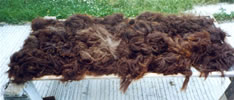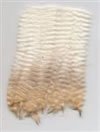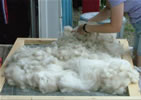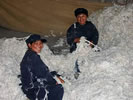| About Alpacas>Fibre |
|
| OK, it comes off the alpaca, but is it fibre, fleece or wool? |
|
|
 |
|
The term wool is only used for alpacas when referring to the end product, for example “A scarf made of alpaca wool”. The words ‘fleece’ and ‘fibre’ are used almost interchangeably but the closer you are to the animal the more likely you are to call it ‘fleece’ and the closer to the processing plant or mill the more likely ‘fibre’. However, the bundle of fibre that comes off an individual alpaca is always called ‘a fleece’. |
|
 |
|
Alpaca fibre is very special and that’s why it’s so much in demand. |
Alpaca fibre is almost the strongest of all natural fibres and this means not only can you make large garments - the Victorians used to make full length alpaca coats which were seen as the mark of a man of substance - but they are also very hard wearing and will last for many years without losing their shape. Despite being so strong, alpaca fibre is also one of the very finest (thinnest) of all fibres. It has no lanolin and this, together with its almost total lack of scales makes it incredibly soft and luxurious against the skin. Even people with high levels of dermatological intolerance to sheep wool can usually wear alpaca next to their skin. And as if that weren’t enough the air-filled cellular structure of alpaca fibre makes it one of the most insulating – and hence warmest – of all fibres.
Not all alpacas produce the same level of excellence.
Prior to the Spanish colonisation of the Andes in the 16th century there had been thousands of years of selective breeding of alpaca which had been highly prized by the Incas for whom alpaca garments were reserved for the nobility and royalty. Subsequently most of the herds were decimated or used for food and no further attempt at improvement occurred until a couple of centuries ago. Even since there have been very few serious players in the South American industry interested enough to take a long term view of fibre improvement. So it has only been very recently – within the last 20 or so years – that we have seen fine alpaca fibre in reasonable quantities. This dramatic improvement has been driven by the entrance of Australia and the USA into the market bringing with them not only the experience (the Australians have been breeding the world’s best wool for nearly a century) but the resources to establish high-end breeding programs.
And that is the gist of it: the business of alpacas is all about qualitative improvement and increasing the numbers of those better-quality alpacas. |
| |
| The excellent fleece. |
|
|
The most important element in a fleece is consistency, and the second is quantity. This may not be what you’ve heard as much talk about fleece quality revolves around subjects like fineness, medulation, and handle. But a fleece that is inconsistent or insubstantial has negligible commercial value, and no matter what your fibre objectives getting sufficient reliable results is the key.
In looking for these elements you will ideally see the following.
- Consistency across the fleece. The characteristics you seek (staple length, fineness, etc.) should be present over the whole fleece.
- Density. The more hairs per square centimetre of skin the greater the yield from the alpaca. This can be measured accurately by taking a sample from a defined area and counting the hairs (a lab will do this for you), or more practically by applying pressure to the fleece by hand and gauging resistance.
- Staple length. The longer the staple the greater the yield. In absolute terms it should be a minimum of about 5cm (say 2inches): less than this is difficult to process. Remember, of course, the fleece is growing all the time so we are only interested in measuring this at shearing time (usually annually). In other words to make a effective comparison between two fleeces they must both be the same ‘age’, for example 10 months since last shearing.
- Coverage. The more the better obviously. Useful fleece starts at the very top of the neck and continues until at least the knees and hocks. Unless your paddocks are exceptionally clean fleece below here will be unusable.
- Absence of guard hair (sometimes referred to as the ‘secondary coat’). Guard hair is much stronger than the primary hair and is highly undesirable as it does not process well so must be removed prior to processing. It often appears longer than the rest of the fleece and is thus usually easy to spot. It is most common across the breast bone and neck but may be present anywhere.
- Colour uniformity. With the exception of multi-coloured animals, the fleece should have a uniform colour throughout. Once the alpaca has been shorn it’s easy to spot variations but this takes time when the fleece is still ‘on the hoof’. Harder still is spotting individual hairs of incorrect colour: black in a white fleece for example.
|
|
| |
| The market |
Having achieved the above we need to identify our market.
In Australia for example, sheep wool has many markets: from soft clothing to hard-wearing carpets, and each market demands a different quality (or blend of qualities) of wool. Thus ‘commercials’ (wool producers) produce three basic grades: ‘fine’, ‘medium’, and ‘strong’.
It is likely that in the future the same will apply to the alpaca industry. Luxury carpet manufacturers will demand a ‘stronger’ (coarser) fibre, suits, coats and rugs will need finer, and next-to-skin clothing makers will always seek out the superfine. For the time being, however, most breeders seem comfortable breeding for fineness, and that is probably sensible (though that’s not to say it wouldn’t be a good idea for some at this stage to work on other qualities: there is certainly a ‘foot in the door’ opportunity to be had).
Assuming fineness is your goal (after consistency and quantity, of course) then there are some elements you should look for. |
| |
|
| |
Handle |
| |
|
No matter what other characteristics a fine fleece exhibits its true character will be exemplified by what it feels like when you get your hand deep into it. This is known as the ‘handle’, and though it takes some time to become proficient, it’s the first thing you should estimate when looking at a fleece. If it feels really good that’s more than half the battle. |
|
 |
| If it feels good... |
|
|
| |
|
| |
Fineness |
| |
|
Diameter of each hair. The thinner the hairs the finer the feel. The absolute measurement is in ‘micron’ (where less than 20 micron is considered ‘superfine’, and greater than 30 is very coarse) and with practice you’ll get very accurate at estimating this with your fingers. |
| |
|
|
| |
Crinkle, crimp, and locks (see photos) |
| |
|
Crinkle is rarely mentioned but is necessary (though not sufficient) for ‘crimp’, and describes the ‘waviness' of a single hair. Multiple hairs, all displaying crinkle, that lie together in a ‘lock’ may then display ‘crimp’. Crimp is seen as highly desirable as it has a high correlation with fineness and uniformity, and makes fibre easier to process. Well defined locks are indicative of well-formed and uniform fleeces. Suri fibre does not exhibit crimp. |
|
 |
| Crimp |
|
|
 |
| Locks |
|
|
| |
|
| |
Lustre |
| |
|
The ability of a lock of fibre to reflect light. The greater the better. Suri fibre tends to be more lustrous than huacaya.
A good method of detecticg lustre is to wrap a lock ticktly around your finger and hold it to a light source.
|
|
 |
| A lustrous suri fleece |
|
|
|
| |
| |
| Shearing |
Unlike sheep, alpacas don’t molt so they can be shorn as infrequently as you wish. Some breeders shear every two years in order to clip as long a staple as possible because many hand spinners find the greater length desirable. This can cause problems however. Unless the paddocks are very clean the fleece will pick up an increasing amount of contaminant and need a lot of preparative cleaning, there is also a risk that the alpaca may suffer heat stress when full-fleeced in the height of summer. In general alpacas are shorn annually, and most breeders in Britain try to shear around June. By this time most of the shows are over, the risk of late frosts is minimal and it is early enough to allow the alpaca to grow sufficient fleece to protect itself against the start of the next winter. Naturally this puts a bit of a strain on resources as everyone wants the shearers at the same time: remember to plan ahead and book your shearer early!
|
|
 |
|
|
| |
|
 |
| 'Skirting' a fleece |
|
|
The ‘clip’ will probably be in the range of 2-5kg overall. It is generally sorted immediately into two or three bags: ‘saddle’, ‘neck’, ‘legs and the rest’. The saddle will almost certainly represent the best of the fleece. The neck, legs, and rest may be combined if the consistency is poor.
|
|
 |
| Sorting fleeces |
|
|
|
| |
|
| Your shearer will also see to your alpaca’s teeth (trimming/removing as necessary)
whilst the animal is restrained. |
|
| |
|
| Selling/marketing |
|
The international market for alpaca product is enormous with demand always exceeding supply, this demand supports consistent premium prices. In Britain the challenge is to supply sufficient of each colour at consistent qualities for the processing to be efficient. We are still desperately short of fibre and the consistency is poor which means many more breeders are needed to supply the market with consistent quality product.
There are alternatives to selling ‘bulk’ to the processors. Some alpaca breeders prefer to home spin their fibre, and those who see the whole process through can add huge value to their fleeces. Current practices suggest that a fleece that would sell for around £20 can be sold as finished products for more than ten times that figure. |
|
|